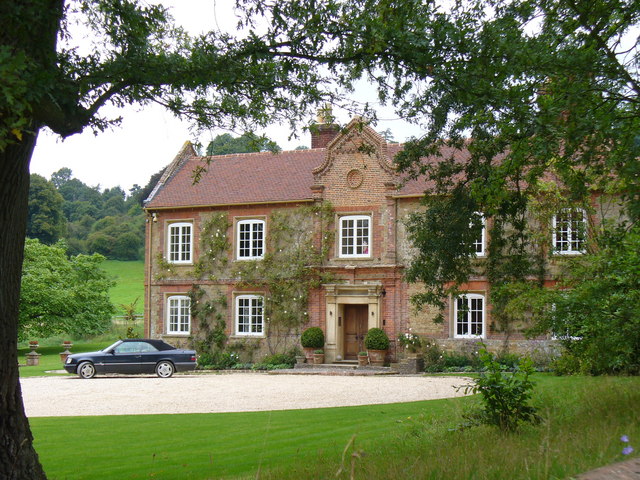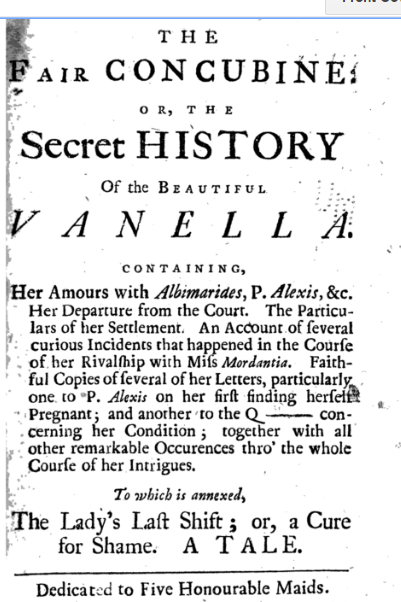|
Elizabeth Vane, Lady Barnard
Elizabeth Vane, Lady Barnard, formerly Lady Elizabeth Holles (c. 1657 – 9 November 1725) was an English noblewoman, the wife of Christopher Vane, 1st Baron Barnard. Her disputes with her family led to a noted court case, and her ghost is reputed to haunt Raby Castle, near Durham. Elizabeth was the daughter of Gilbert Holles, 3rd Earl of Clare, and his wife, the former Grace Pierrepont. After her marriage to Vane in 1676, she fell out with her younger brother and co-heir, John Holles, 1st Duke of Newcastle-upon-Tyne, who inherited their father's title. They had three children: A family dispute began when Lord Barnard's heir, Gilbert, decided to marry Mary Randyll. Mary, the daughter of politician Morgan Randyll, was described as "scandalous" by Christopher Vane, and it would later be thought that Gilbert and Mary's daughter, Anne Vane, had followed her mother's example when she became a mistress of Frederick, Prince of Wales.Matthew Kilburn, 'Vane, Anne (d. 1736)’, Oxford Diction ... [...More Info...] [...Related Items...] OR: [Wikipedia] [Google] [Baidu] |
Christopher Vane, 1st Baron Barnard
Christopher Vane, 1st Baron Barnard (21 May 1653 – 28 October 1723) was an English peer. He served in Parliament for Durham after his brother, Thomas, died 4 days after being elected the MP for Durham. Then, again from January 1689 - November 1690 for Boroughbridge. He served in the Commons as a Whig collaborator during the passage of the Bill of Rights which his father, Sir Henry Vane, the Younger had fought for religious and civil liberty before his beheading in 1662. He is known for his disputes with his heirs and for employing Peter Smart, father of the poet Christopher Smart, as a steward. Early life Christopher Vane was the son of Henry Vane the Younger Sir Henry Vane (baptised 26 March 161314 June 1662), often referred to as Harry Vane and Henry Vane the Younger to distinguish him from his father, Henry Vane the Elder, was an English politician, statesman, and colonial governor. He was brie ... and Frances Wray, daughter of Christopher Wray (MP), Sir Christopher ... [...More Info...] [...Related Items...] OR: [Wikipedia] [Google] [Baidu] |
Raby Castle
Raby Castle () is a medieval castle located near Staindrop in County Durham, England, among of deer park. It was built by John Neville, 3rd Baron Neville de Raby, between approximately 1367 and 1390. Cecily Neville, the mother of the Kings Edward IV and Richard III, was born here. After Charles Neville, 6th Earl of Westmorland, led the failed Rising of the North in favour of Mary, Queen of Scots in 1569 Raby Castle was taken into royal custody. Sir Henry Vane the Elder purchased Raby Castle in 1626 and neighbouring Barnard Castle from the Crown, and the Earls of Darlington and Dukes of Cleveland added a Gothic-style entrance hall and octagonal drawing room. From 1833 to 1891 they were the Dukes of Cleveland and they retain the title of Lord Barnard. Extensive alterations were carried out in the 17th and 18th centuries. It is famed for both its size and its art, including works by old masters and portraits. After 1733 it was frequented from his young age of el ... [...More Info...] [...Related Items...] OR: [Wikipedia] [Google] [Baidu] |
Gilbert Holles, 3rd Earl Of Clare
Gilbert Holles, 3rd Earl of Clare (24 April 1633 – 16 January 1689) was an English politician who sat in the House of Commons in 1660. He was styled Lord Haughton from 1637 until he succeeded to the title Earl of Clare in 1666. Life Holles was the son of John Holles, 2nd Earl of Clare and Elizabeth Vere, daughter of Horace Vere, 1st Baron Vere of Tilbury. He was baptised at the Church of St John-at-Hackney on 18 May 1633. His godfathers were his grandfathers, John Holles, 1st Earl of Clare and Horatio, Baron Vere: his godmother was Mary Courteen, Countess of Kent. He travelled abroad in 1645. In April 1660, he was elected Member of Parliament for Nottinghamshire in the Convention Parliament. ://www.historyofparliamentonline.org/volume/1660-1690/member/holles-gilbert-1633-89 History of Parliament Online – Holles, Gilbert, Lord Houghton] Holles died in 1689 and was buried at Haughton. [...More Info...] [...Related Items...] OR: [Wikipedia] [Google] [Baidu] |
John Holles, 1st Duke Of Newcastle-upon-Tyne
John Holles, Duke of Newcastle-upon-Tyne, Order of the Garter, KG, Privy Council of the United Kingdom, PC (9 January 1662 – 15 July 1711) was an English Peerage of the United Kingdom, peer. Early life Holles was born in Edwinstowe, Nottinghamshire, the son of the Gilbert Holles, 3rd Earl of Clare, 3rd Earl of Clare and his wife Grace Pierrepont. Grace was a daughter of The Hon. William Pierrepont and granddaughter of the Robert Pierrepont, 1st Earl of Kingston-upon-Hull, 1st Earl of Kingston-upon-Hull. Politics Holles was elected MP for Nottinghamshire (UK Parliament constituency), Nottinghamshire as Lord Houghton on 14 January 1689, but was called to the House of Lords two days later when his father died and he became the 4th Earl of Clare. He was created the Duke of Newcastle-upon-Tyne, of the 2nd creation, in 1694. The Duke of Newcastle-upon-Tyne is a title which was created three times in British history. The first creation had become extinct when his father-in-law Henry ... [...More Info...] [...Related Items...] OR: [Wikipedia] [Google] [Baidu] |
Morgan Randyll
Morgan Randyll (1649 – 1738 or later), of Chilworth Manor, Surrey was an English lawyer and Tory politician who sat in the English and British House of Commons between 1679 and 1722. Randyll was the eldest son of Vincent Randyll of Chilworth and his wife Dorothy Duncombe, daughter of John Duncombe of Weston, Surry. He matriculated at Wadham College, Oxford, in 1666 and was awarded a BA in 1670, and in the same year was admitted at the Middle Temple. In 1673, he inherited Chilworth Manor from his father. In 1677, he was called to the bar. He married Anne Gould, the daughter and coheiress of Sir Thomas Gould, draper, of Aldermanbury, Londonby licence dated 5 February 1678. Randyll was elected a Member of Parliament for Guildford in October 1679 and again in 1681. He was selected High Sheriff of Surrey for the year 1686 to 1687 and served as a Deputy-lieutenant of the county from February to October 1688 and from 1702 onwards. He was returned again for Guildford in 1690, 1695, 1 ... [...More Info...] [...Related Items...] OR: [Wikipedia] [Google] [Baidu] |
Anne Vane
Anne Vane (17 September 1710 - 27 March 1736), also known as "the Hon. Mrs. Vane," was a maid of honour to Caroline of Ansbach and mistress to her son Frederick, Prince of Wales. Life Vane was the first daughter of Gilbert Vane, second Baron Barnard, and sister to the politician Henry Vane who was the first Earl of Darlington. Her mother, Mary (born Randyll), was described as "scandalous" by her father-in-law (i.e. Anne's paternal grandfather), Christopher Vane, 1st Baron Barnard, and Anne inherited her reputation. Vane became a maid of honour to Caroline, Princess of Wales, who became queen consort in 1727 as the wife of George II. Vane's mother, Mary, died on 4 August 1728.Matthew Kilburn, ‘Vane, Anne (d. 1736)’, Oxford Dictionary of National Biography, Oxford University Press, 2004; online edn, May 200accessed 19 Feb 2017/ref> When Caroline's son Frederick came to England in 1728 and was in turn made Prince of Wales in 1729, he made Vane his mistress and publicly acknowl ... [...More Info...] [...Related Items...] OR: [Wikipedia] [Google] [Baidu] |
Frederick, Prince Of Wales
Frederick, Prince of Wales, (Frederick Louis, ; 31 January 170731 March 1751), was the eldest son and heir apparent of King George II of Great Britain. He grew estranged from his parents, King George and Queen Caroline. Frederick was the father of King George III. Under the Act of Settlement passed by the English Parliament in 1701, Frederick was fourth in the line of succession to the British throne at birth, after his great-grandmother Sophia, Dowager Electress of Hanover; his grandfather George, Elector of Hanover; and his father, George, Electoral Prince of Hanover. The Elector ascended the British throne in 1714. After his grandfather died and his father became king in 1727, Frederick moved to Great Britain and was created Prince of Wales in 1729. He predeceased his father, however, and upon the latter's death in 1760, the throne passed to Frederick's eldest son, George III. Early life Prince Frederick Louis was born on in Hanover, Holy Roman Empire (Germany), as Du ... [...More Info...] [...Related Items...] OR: [Wikipedia] [Google] [Baidu] |
Shipbourne
Shipbourne ( ) is a village and civil parish situated between the towns of Sevenoaks and Tonbridge, in the borough of Tonbridge and Malling in the English county of Kent. In 2020 it was named as the most expensive village in Kent. It is located in an undulating landscape traversed by the small streams of the River Bourne, set in a clay vale at the foot of the wooded Sevenoaks Greensand Ridge. The landscape is agricultural with dispersed groups of buildings that are almost entirely residential or used for farming purposes. The dominant characteristics of the historical landscape are thick woodland with smaller, broadleaf coppices with small to medium-sized fields enclosed by traditional boundaries of hedges or chestnut fencing. Earlier removal of some hedgerows has resulted in some larger arable fields; these are often separated by small woodland belts or shaws. The most distinctive landscape feature is The Common, also known as The Green, which is a large, open and dominant spac ... [...More Info...] [...Related Items...] OR: [Wikipedia] [Google] [Baidu] |
1650s Births
Year 165 ( CLXV) was a common year starting on Monday (link will display the full calendar) of the Julian calendar. At the time, it was known as the Year of the Consulship of Orfitus and Pudens (or, less frequently, year 918 ''Ab urbe condita''). The denomination 165 for this year has been used since the early medieval period, when the Anno Domini calendar era became the prevalent method in Europe for naming years. Events By place Roman Empire * A Roman military expedition under Avidius Cassius is successful against Parthia, capturing Artaxata, Seleucia on the Tigris, and Ctesiphon. The Parthians sue for peace. * Antonine Plague: A pandemic breaks out in Rome, after the Roman army returns from Parthia. The plague significantly depopulates the Roman Empire and China. * Legio II ''Italica'' is levied by Emperor Marcus Aurelius. * Dura-Europos is taken by the Romans. * The Romans establish a garrison at Doura Europos on the Euphrates, a control point for the commercial ro ... [...More Info...] [...Related Items...] OR: [Wikipedia] [Google] [Baidu] |
.jpg)
_MET_DP-12800-026.jpg)


.jpg)